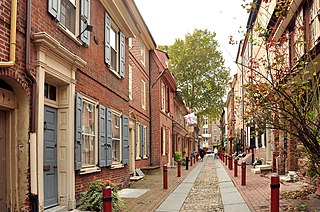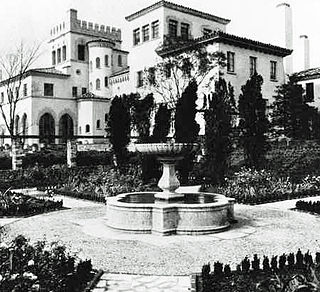The National Register of Historic Places (NRHP) is the United States federal government's official list of districts, sites, buildings, structures, and objects deemed worthy of preservation for their historical significance or "great artistic value". A property listed in the National Register, or located within a National Register Historic District, may qualify for tax incentives derived from the total value of expenses incurred in preserving the property.

The New York City Landmarks Preservation Commission (LPC) is the New York City agency charged with administering the city's Landmarks Preservation Law. The LPC is responsible for protecting New York City's architecturally, historically, and culturally significant buildings and sites by granting them landmark or historic district status, and regulating them after designation. It is the largest municipal preservation agency in the nation. As of July 1, 2020, the LPC has designated more than 37,800 landmark properties in all five boroughs. Most of these are concentrated in historic districts, although there are over a thousand individual landmarks, as well as numerous interior and scenic landmarks.

Historic preservation (US), built heritage preservation or built heritage conservation (UK) is an endeavor that seeks to preserve, conserve and protect buildings, objects, landscapes or other artifacts of historical significance. It is a philosophical concept that became popular in the twentieth century, which maintains that cities as products of centuries' development should be obligated to protect their patrimonial legacy. The term refers specifically to the preservation of the built environment, and not to preservation of, for example, primeval forests or wilderness.

The National Historic Preservation Act is legislation intended to preserve historic and archaeological sites in the United States of America. The act created the National Register of Historic Places, the list of National Historic Landmarks, and the State Historic Preservation Offices.

Adaptive reuse refers to the process of reusing an existing building for a purpose other than which it was originally built or designed for. It is also known as recycling and conversion. Adaptive reuse is an effective strategy for optimizing the operational and commercial performance of built assets. Adaptive reuse of buildings can be an attractive alternative to new construction in terms of sustainability and a circular economy. It has prevented thousands of buildings' demolition and has allowed them to become critical components of urban regeneration. Not every old building can qualify for adaptive reuse. Architects, developers, builders and entrepreneurs who wish to become involved in rejuvenating and reconstructing a building must first make sure that the finished product will serve the need of the market, that it will be completely useful for its new purpose, and that it will be competitively priced.

Conservation and restoration of immovable cultural property describes the process through which the material, historical, and design integrity of any immovable cultural property are prolonged through carefully planned interventions. The individual engaged in this pursuit is known as an architectural conservator-restorer. Decisions of when and how to engage in an intervention are critical to the ultimate conservation-restoration of cultural heritage. Ultimately, the decision is value based: a combination of artistic, contextual, and informational values is normally considered. In some cases, a decision to not intervene may be the most appropriate choice.

The Ontario Heritage Act, first enacted on March 5, 1975, allows municipalities and the provincial government to designate individual properties and districts in the Canadian Province of Ontario, as being of cultural heritage value or interest.

The Georgia Trust for Historic Preservation is the United States' largest statewide, nonprofit preservation organization with more than 8,000 members. Founded in 1973 by Mary Gregory Jewett and others, the Trust is committed to preserving and enhancing Georgia's communities and their diverse historic resources for the education and enjoyment of all.

The Belleview-Biltmore Resort and Spa was a historic resort hotel located at 25 Belleview Boulevard in the town of Belleair, Florida, United States. The 350,000 square feet (33,000 m2) hotel structure was the last remaining grand historic hotel of its period in Florida that existed as a resort, and the only Henry Plant hotel still in operation when it closed in 2009. The building was noted for its architectural features, with its green sloped roof and white wood-sided exterior, and handcrafted woodwork and Tiffany glass inside. Constructed of native Florida heart pine wood, it was the second-largest occupied wooden structure in the United States after 1938; only the Hotel Del Coronado in San Diego was larger.

Historic districts in the United States are designated historic districts recognizing a group of buildings, archaeological resources, or other properties as historically or architecturally significant. Buildings, structures, objects, and sites within a historic district are normally divided into two categories, contributing and non-contributing. Districts vary greatly in size and composition: a historic district could comprise an entire neighborhood with hundreds of buildings, or a smaller area with just one or a few resources.

In the law regulating historic districts in the United States, a contributing property or contributing resource is any building, object, or structure which adds to the historical integrity or architectural qualities that make the historic district significant. Government agencies, at the state, national, and local level in the United States, have differing definitions of what constitutes a contributing property but there are common characteristics. Local laws often regulate the changes that can be made to contributing structures within designated historic districts. The first local ordinances dealing with the alteration of buildings within historic districts was enacted in Charleston, South Carolina in 1931.

The U.S. National Register of Historic Places (NRHP) classifies its listings by various types of properties. Listed properties generally fall into one of five categories, though there are special considerations for other types of properties which do not fit into these five broad categories or fit into more specialized subcategories. The five general categories for NRHP properties are: building, district, object, site, and structure.

Walnut Hills United Presbyterian Church is a historic church tower in the Walnut Hills neighborhood of Cincinnati, Ohio, United States. The last remnant of a landmark church building, it was designed by a leading Cincinnati architect and built in the 1880s. Although named a historic site a century after its construction, the building was mostly destroyed after extensive neglect caused restoration to become prohibitively expensive.

Los Angeles Historic-Cultural Monuments are sites which have been designated by the Los Angeles, California, Cultural Heritage Commission as worthy of preservation based on architectural, historic and cultural criteria.

La Ronda was a mansion and estate in Bryn Mawr, Pennsylvania from 1929 to 2009. It was originally the home of Percival E. Foerderer, who ran a leather-manufacturing business, and his wife Ethel Brown. The 17,500-square-foot (1,630 m2) Philadelphia Main Line mansion was the last commission by the renowned early 20th century architect Addison Mizner based in Palm Beach, Florida. The residence was built by J.S. Cornell & Son.

A Cultural Property is administered by the Japanese government's Agency for Cultural Affairs, and includes tangible properties ; intangible properties ; folk properties both tangible and intangible; monuments historic, scenic and natural; cultural landscapes; and groups of traditional buildings. Buried properties and conservation techniques are also protected. Together these cultural properties are to be preserved and utilized as the heritage of the Japanese people.

The destruction of country houses in 20th-century Britain was the result of a change in social conditions: many country houses of varying architectural merit were demolished by their owners. Collectively termed by several authors "the lost houses", the destruction of these now often-forgotten houses has been described as a cultural tragedy.

Washington County History & Landmarks Foundation is a non-profit educational institution in Washington, Pennsylvania, United States. Its purpose is to encourage and assist the preservation of historic structures in Washington County, Pennsylvania. The foundation operates its own landmark certification process, as well as working with the National Park Service to document and place landmarks on the National Register of Historic Places. It also offers advice and assistance for historic building owners who wish to preserve their facilities. Since its inception, the foundation has been successful in helping many historic building owners in the preservation of their structures.
Wintersburg Village is an area in Huntington Beach, California, United States, that represents over a century of Japanese immigration to the United States. The property, consisting of six structures on a 4.5-acre (1.8 ha) parcel, was noted as eligible for the National Register of Historic Places in the City of Huntington Beach General Plan in 2014. The C.M. Furuta Gold Fish Farm and the Wintersburg Japanese Mission are recognized nationally by historians as a rare, pre-1913 Japanese pioneer-owned property with intact physical features that convey the progression of Japanese American history.

The Niagara Apothecary was an apothecary in Niagara-on-the-Lake, Ontario, established no later than 1820, and is now a National Historic Site of Canada. It was operated by a series of successive owners, most of whom had apprenticed under the preceding owner. In the 1960s, it was purchased by the Niagara Foundation, which targeted the building and its contents for preservation. It was purchased by the provincially-owned Ontario Heritage Foundation in 1969, which undertook a preservation effort culminating in May 1971, when the property was re-opened as a museum.


















